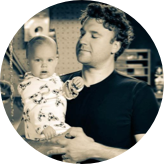You are about to become a new dad. Congratulations! No sugarcoating this: you’re embarking on one of the toughest experiences of your life. And one of the most rewarding, too. Not only have you been tasked with the responsibility of taking care of a newcomer to this world, supporting them in their growth and development, and challenging them in ways that they reach their potential—and to look like you know what you are doing. Going in cold, most of us have no idea what we are doing, which is why you’re here. You’ve got questions, and we have answers! Because we’ve been there. We’ve seen things you wouldn’t believe…
Enough of the thousand mile stare. Here is your definitive checklist for becoming a new dad!
1. Read up
One of the first steps in being prepared for the arrival of your baby is getting educated on what to expect. You can find plenty of resources for this, and you should check into as many of them as you can. Just keep in mind that the information can be a little overwhelming. Some books might seem to have a negative take on what can go wrong as a parent, from dealing with difficult pregnancies, complications, illnesses, and the like. Some parents are scared silly by these books. It’s good to temper your reading with keeping communication open with other parents. Neither books nor advice is going to cover all the bases, but they should be considered good resources. Read through the books, take notes, write down your thoughts in the margins. Chances are you are going to surprise yourself with your perspective years later when you are an old salt at this. Just remember as kids growing up, TV made us think that quicksand was going to be a bigger problem in our lives than it wound up being.
Make it happen: our list of the best books for new and expecting dads.
2. Find a birthing class
Either through your partner’s OB/GYN or the hospital, you can find resources on birthing courses. Movies have made these comically cliched with couples sitting around on yoga mats doing breathing exercises, but real birthing classes offer an experience that is important during the pregnancy. Birthing classes allow you to spend time with your partner, focusing only on what they are going through in a frank and clear way. Childbirth has been mystified in many ways or treated in a way that focuses on ridiculous things like racing across town to the hospital during labor. It is a natural process that everyone has experienced in one way or the other. Like any bodily process, pregnancy doesn’t care about social mores or etiquette. There are bodily functions: gas, nipple sensitivity, mucous, pain, anxiety, and so many others. A birthing class will help you get over many of these stigmas, and usually allow you to connect with others who are also going through the childbirth experience. You’ll see that everyone is different and dealing with the process in different ways.
Make it happen: check in with your partner’s OBGYN or the local hospital where your partner plans to give birth.
3. Attend a daddy bootcamp or take an online course
One of the most useful and often overlooked ways to educate yourself, many hospitals and local organizations offer interactive bootcamps that prepare parents-to-be with hands-on experiences of things you will need to know. Some of these classes bring in actual newborns to demonstrate how to effectively swaddle a newborn, change diapers, burp the baby, and answer any questions you might be reluctant to ask. Just remember, there are no stupid questions. Just remember to leave the jokes at the door and keep your eyes and ears open. If you’re more the learn from the comfort of your own home type, there are also plenty of online courses for expecting parents or dads.
Make it happen: search for local daddy bootcamps, or check out our list of the best online courses for expecting parents or our very own Father’s Ed course.
4. Get involved
Just because your partner is carrying the baby around doesn’t mean that all of the responsibility belongs to her, and it doesn’t mean that you have appointed yourself supervisor of the pregnancy/child-rearing either. It’s a partnership. How well you work together during the pregnancy will play out later in life when your kid starts asking the hard questions. If you are both on the same page, or know how to respectfully disagree with each other, you will have a better experience and raise kids who recognize healthy boundaries and relationships.
Make it happen: demand your partner doubles her prenatal vitamin dose, then start to get more intrusive. JK, terrible idea. Instead, attend OB appointments, and ask how you can support.
5. Set a good game plan
Talk with your partner about both of your expectations of what you both want. This includes how to split up the parenting duties, such as division of labor, parenting style, and even discipline. These kinds of boundaries can be adjusted as you need them to be, based on what is best for you both as well as the baby. It’s a good way to establish who does what, working in shifts, and making each other’s lives easier. Remember that plans change, and the emotional and physical exhaustion might mean your plan of who does the dishes and when isn’t written in stone.
Explore lots of different details you might have taken for granted. For example, you and your partner might have viewpoints of religious ceremonies, circumcision, Christening, etc. that probably didn’t come up during dinner when you were just dating. Some people have different viewpoints on vaccinations as well, which will be important to address between parents. It might also be some good groundwork to lay as far as visitors, in-laws helping out, and how long guests can stay while you are getting settled in with your new lives.
Make it happen: explore some of our checklists for expecting parents, which include prompts on conversation starters for couples.
6. Start to think about your parenting style
It’s always good to brainstorm with your partner your expectations for a parenting style. Many of us go through life with a reactive viewpoint. We say things like “My parents were too hard on me, I’m not going to be like that with my kid!” or we might feel like we weren’t pushed hard enough. Little details like letting your baby cry it out during sleep training, co-sleeping, or holding your baby can be addressed now, rather than in an argument when you are both exhausted and emotional. Consistency is important in raising a child, and being on the same page–or knowing how to constructively disagree–will get you a lot of ground later on, not only for your own sanity, but because your kid will understand their own boundaries if both parents are a unified front.
Make it happen: write a 5 paragraph essay, ask your partner to sign off. Nope, wrong again. But, do jot down some thoughts—it’s profound what writing can do to organize your thinking—and share it with your partner. Things that went well, and didn’t, in your respective childhoods is a deep, but powerful starting point.
7. Get some toys
Parenthood is not all soft-molded plastic animals in obnoxious colors. You can get some toys for you too! There are more cool baby gadgets and ways to make your life easier than James Bond gets from Q these days. Baby monitors, strollers, wagons, car seats, HD surveillance systems, diaper bags for dads, and all the other accoutrements of being a new dad are a flat-out blast to use. Not only do they help with your child’s comfort, development, and all that good stuff we are supposed to care about, they are really fun for you too! Most of this stuff is available in designs and colors that don’t make you look like you are carrying around a bunch of plastic junk or pink-polka-dot bags anymore.
Make it happen: get comfortable with the basics, and beyond basics, with our essential gear for newborns list.
8. Get all cozy and start nesting
You might have heard about this and it is unbelievable to watch once you are swept up in it. As bizarre as it might sound with your partner who used to enjoy sushi bars, whiskey shooters, rock climbing, or spear fishing to see them now geeking out over the difference between lemon yellow and canary yellow for the baby’s room, it is totally real. As you approach the due date, your honey-do list might have increased exponentially. You might even come home to your partner mid-project, grouting the shower. This is a great opportunity for you both to have some fun with making your house a home together to welcome baby into the world. Together you can accomplish a lot, from that last deep cleaning (since you’ll both have your hands full once the newborn arrives) to just getting some projects knocked out that you’ve been meaning to get done for a while. Just remember to make sure the projects are safe for mom and won’t take too long, since you won’t have time for them for a while after baby comes home.
Nesting can include the following:
- Repainting rooms
- Wallpaper
- Deep cleaning
- Shampooing carpets, refinishing floors, etc.
- Rearranging furniture
- Setting up baby furniture such as cribs, bassinets, swings, changing tables, etc.
- Baby-proofing the house
- Cleaning out the attic/garage/basement
- Fixing leaking plumbing
- Many, many more!!
Make it happen: study this list of the the top 75 shades of yellow for baby nurseries 2022 (<— we wouldn’t be surprised if that list exists, but we refuse to link to it). Instead, head to Home Depot/Pottery Barn Kids/Crate & Barrel/Target/Your weapon of choice … you’ll be surprised, even if you’re the most macho of manly men, how you get into this.
9. Find a pediatrician
Believe it or not, you will be going to the doctor a lot as a new parent. Not just because of vaccinations, post-natal tests, and well-checks, but also the inevitable virus, childhood illnesses such as cradle cap, rashes, and baby acne. Even if your child is perfectly healthy, a good pediatrician is not only there for emergencies or medical concerns, but also serves as a good reference for information about your child’s health and development. There are a variety of resources you can use to find a pediatrician who is right for you. One of the best is networking with friends and other parents. Word of mouth is a recommendation that beats any online review, especially if someone has had a great or not-so-great experience with a pediatrician. Bedside manner, your child’s comfort, and the doctor’s experience all factor into picking the right doc for your child.
Make it happen: ask 3 friends who have parents what they think of their pediatrician. Or, search for board-certified pediatricians close to you. You don’t want much more than a 10-15 minute drive. Rule out anyone wearing a clown nose in their headshot.
10. Talk about breast feeding vs. bottle Feeding
This is an extremely important and personal experience. Learning about it prior to childbirth can prepare you both for all sorts of challenges. From difficulties in latching to nutrition to freeing up time for all of you, there are many resources to help you along the way. From breast pumps to formula feeding, it is an important topic of discussion that deserves attention.
Make it happen: start this discussion with your partner, get her initial take. Talk to her OB & your new-found pediatrician (see above—this makes for a great interview question for that doc).
11. Get or update your life insurance and will
This might seem like a total buzzkill to think about as you are bringing life into this world, but as a dad you have a responsibility to care for and support your child even after unforeseeable tragic events. It is a good time to talk with your partner about how to take care of your child if anything happens to either or both of you. Guardianship, financial support, and a way to provide for them if you are gone is as important now as it will ever be.
Make it happen: talk with your partner about planning for the unexpected, and both of your wishes. Google term life insurance—you may find it’s more affordable than you think, but it may also require a medical exam and some time, so start early.
12. Prep for labor and delivery
Very few labor and delivery stories play out like they do in the movies. Which is a good thing. The process of labor and childbirth often occurs over a number of days. Have a birthing plan, but also keep in mind that plans change depending on the situation. You aren’t married to your birthing plan and every experience is going to be different.
Here are some things you should know and expect when the time comes:
Hurry up and wait
By now you should know about female anatomy, biological functions, and the basics of the birds and bees to have gotten you this far. In case you missed that day in your birthing classes, here’s a quick run down:
The baby gestates over a period of nine months (roughly 40 weeks) from fetus to baby in a protective sack called the placenta through which it gets all of its nutrients, protection, and cable TV. It hangs out there, often in an upside down position until the time comes for the uterus to evict that kid. The female body produces a lot of hormones that are required to get the process moving such as serotonin, oxytocin, and even cortisol. These are the feel good and fight or flight hormones. They also serve a purpose in dilation of the opening of the cervix. It expands from the size of a pinhead to around grapefruit size. This process is measured by the doctor and nurses through visual examination. It can take anywhere between a couple of hours to a few days, depending on the hormone levels. During dilation, the uterus is contracting, moving the kid around into position to begin the process of birth.
Also, if these terms make you uncomfortable, you need to work on that, because you’ll be hearing them a lot.
Water breaking
You might be familiar with this term already. It is what happens when the placenta breaks and may facilitate or be an indication of childbirth. Generally a mucus plug is flushed out of the body during this as well. The amniotic fluid which suspends the baby, drains through the vagina. It is important to note any discoloration or blood in the amniotic fluid as this may indicate a serious problem such as meconium or distress. Water breaking is often a good indication labor has started, but not necessarily true with all moms. Sometimes the doctor has to rupture the amniotic sack manually. This is also normal.
Contractions
Contractions are uncomfortable, to say the least. Your partner might be encouraged to walk during labor, which helps facilitate dilation and childbirth. Contractions come and go throughout the process. Consult your doctor, but contractions several minutes apart indicate true labor. Irregular contractions might be sign of a false labor or need to speed things along with induced labor. You aren’t a doctor (unless, maybe you are), so don’t try to diagnose. Be open with the doctor with any questions you might have.
Pain management
Painful is a word for it. So is agonizing. In all cases the pain can be exhausting. Be prepared to talk about pain management with the doctor. There is a limited window to administer an epidural or other pain management before active labor begins. Talk with your doctor early on about pain management.
Active labor
This is what Hollywood plays up. The contractions, the breathing, the screaming. Everyone’s childbirth is going to be different. Don’t believe the movies and enjoy the experience together. It is a challenge which will yield amazing rewards. Also, don’t take anything your partner says during active labor personally. Be supportive. Participate. Try not to be that dad who faints during delivery.
Delivery
This is where things really start to move fast. The baby is delivered (either vaginally or by c-section) and each poses its own set of challenges. The doc will probably hand you a pair of scissors to cut the umbilical cord. The rest will be a blur. Hold on for dear life.
Post labor recovery
This is the period of letting mom rest and beginning the rest of your lives with your new addition. Talk to the doctor about concerns such as post-partum depression, anxiety, and any concerns to watch out for during this process. Be supportive and accommodating with your partner. They’ve just been through more than you can imagine.
Taking baby home
You will be expected to have the necessary equipment to care for your child at home. The hospital staff will not let you leave with your baby unless they are buckled into a suitable infant car seat. The rest is up to you.
Make it happen: Tour your chosen hospital. Do your prep work ahead of time. Expect the unexpected. Know you got this.
Good luck. You got this.
People become parents every day, which is why we try to support and engage with other new parents, to help make the experience as fun and worthwhile as possible. It can be a scary time and isn’t without its rollercoaster moments. Finding support and solidarity with your partner as well as other parents is part of what has kept our species on the planet as long as we’ve been here. It’s scary, frustrating, messy, and yet one of the most rewarding things you could ever hope to experience. Check our site, Fathercraft, for tons more tips, advice, reviews, and other resources to help you on your parental journey.








